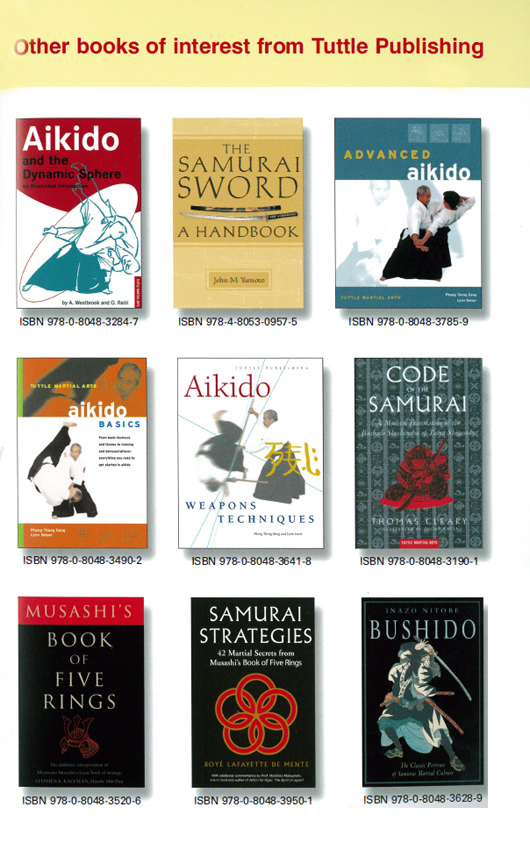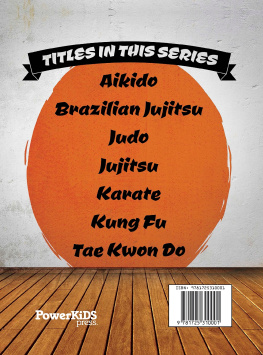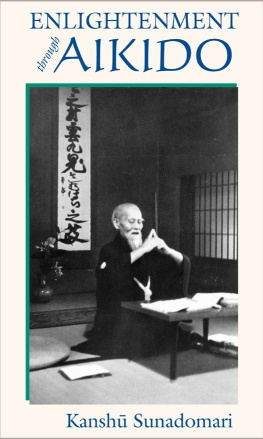ACKNOWLEDGEMENTS
To all those people who have in one way or another contributed to the making of this book: through your constant encouragement, patience and understanding, you supported me and helped me to dear my mind and focus my energy.
To Founder Morihei Ueshiba, the creator of aikido. Undeniably the greatest martial artist the world has ever known, he taught us that we are the Universe and that through the virtue acquired from devoted practice, we can perceive the principles of heaven and earth. I thank him for sharing with us this impeccable martial art.
To Master Koichi Tohei, my mentor, the teacher who first showed me the way of Aiki, and who taught me the very important fundamentals of proper aikido waza. I will always be grateful to him.
To Christopher Watson, Shibu-cho, my co-author. I am deeply indebted to him, especially for his insight in preparing this book. His tremendously focused thinking and writing skills have brought aikido into a new dimension. His patience, encouragement and love of the wonderful philosophy of aikido, and our dose friendship, will always be appreciated.
To Mark S. Sonny RoobinShibu-cho, Orlando, Floridawho has on many occasions listened to my stories with a very attentive ear. He has accompanied me on many adventures abroad and has proved to be a valuable asset in our growing organization. I will always be grateful for his loyalty and interest in maintaining continuity in our cause.
To Jackie Watson, of whom I affectionately think of as my little sister. I thank you for your unselfish time and love, your total involvement in the growth of our aikido, the preparation of this book, and especially your loyalty and devotion to me and my quest.
To Randy Shermansenior instructor, Aikido of Richmond, Virginiafor his unselfish support and enthusiasm in providing the design and layout of this book.
To Fenwick AckermanShibu-cho, Atlanta, Georgiafor his time and valuable suggestions, and especially for his inspiring thoughts and confidence in me. Special thanks to him for his hospitality in opening his dojo to us for the photography sessions that yielded the photos in this book.
To Chad TaylorDojo-cho, Clemson Universitywho in the past six years has been such a devotee to the development and growth of our aikido style and organization, and for serving as my primary uke for the techniques demonstrated in this book.
To Yoko Heffnersenior instructor, Hombu dojo who provided the wonderful and artistic Japanese calligraphy for this book. Domo arigato gozaimasu.
Finally, to Sean and Laura Chartier go my deep appreciation for their time and professionalism in the production of the photos that appear in this book.
Special thanks go to the following students for their support and assistance: Steven Steele, Shibu-cho and chief instructor, Aikido of Richmond; Ed Parent, David Isgett and Ray McClain, senior instructors, Hombu dojo ; Scott Hager, Aikido of Greenville, North Carolina at East Carolina University; Tom Manson and Leigh Manson, Aikido of Key West, Florida; Michael Hawley, Aikido of Buffalo, New York; Tim Ackerman and Eric and Derric Glenn, Atlanta dojo ; and Frances Melfi, Tony Eustis, Christina Giles, and Perry Lambert, Hombu dojo .
To my Dad, Warren Kenji Suenaka, who was the first teacher in my life. He was always there for me with care and support. He taught me the meaning of life, and how to be a survivor.
To the most wonderful girl in my life, my wife, Kanako. My guardian angel, she was always at my side through thick and thin. She taught me the meaning of true love. Also to our children, Valerie and John, and my energetic grandson, Atao, for their loyalty, total commitment, strength and love. You are my closest friends.
To Michael A. DeMarco, Editor-in-Chief, Journal of Asian Martial Arts, for publishing our first major magazine article, and for his support in providing the resources and opportunity leading to the publication of this book.
Lastly, but not least, my deepest appreciation to Mark Wiley and his staff at Charles E. Tuttle, Co. (in my opinion, the authoritative martial arts publisher) for his enthusiastic work in making this book a reality.
Roy Suenaka
For their early support and belief, well-deserved thanks go to editor Mark Wiley at Charles E. Tuttle, Co., and Michael DeMarco, publisher of the excellent Journal of Asian Martial Arts .
While all members of the Wadokai were unfailingly supportive during the genesis and creation of Complete Aikido: Aikido Kyohan, certain people deserve particular mention: Richard Shainwald, for his hospitality during the initial interview sessions; Christopher Caile, for his assistance in the interview process, particularly in matters of karate; Sonny Roobin, for his rock-solid faith and blunt, on-target assessments; Fenwick Ackerman, for his insight and common-sense counsel; and Michael Hawley, a exemplary aikidoka and human being. Thanks as well to the Wadokai aikidoka who patiently posed for the photographs at their own expense, some of whom drove literally halfway across the country to be a part of this enterprise.
Randall Sherman of Cook Sherman Inc . selflessly gave of his time and considerable talents in the design and layout for Complete Aikido: Aikido Kyohan . His crisp professionalism and unflagging support were invaluable in making this work a reality, and is reflected in every page. Thanks as well to Mr. Shermans partner, Ken Cook, for his design contribution and support of the project. Likewise, photographers Sean and Laura Chartier put their lives on hold for one intense Atlanta weekend during which over 800 waza , taiso and ukemi photographs were taken, from which those that appear in this book were selected. Their superb work was the final element that pulled together over three years of labor.
Yoko Heffner kindly provided the kanji that begin every chapter gokuro sama deshita, Y o ko-san.
Special thanks to my wife, Jackie, for her proofreading, suggestions, support, encouragement, and belief, and to my parents, Charles and Betty Watson, for raising me to walk the Path.
Finally, my heartfelt thanks to Roy Yukio Suenaka Sensei for inestimably enriching my life, and for affording me the honor of assisting in this enterprise. Your friendship and tutelage are true blessings for which I shall be forever grateful. May this work serve as a humble gift of thanks for everything you have unselfishly given to me, and to us all.
Christopher Watson

AFTERWORD
Throughout our lives, we have all at one time or another been told to stick to our guns, or do what we feel is right. It is overly simplistic to say it is not always easy to follow such advice, regardless of the truths contained therein. When such maxims are immersed in the reality of everyday life, they quite often become victims of the conflicts and politics inherent in survival. The immediate rewards for succumbing to the pressures and temptations of the moment may be alluring, and we may perhaps justifiably assert that such rewards are deserved, but too often the price for such compromise is an uneasy conscience that lasts long after the gleam has faded from the prize. The coin of character is patience; the rewards are not always immediate, but they do come.
In 1976, Roy Yukio Suenaka Sensei chose the latter course, standing on the firm foundation of his character in the face of what was one of the most difficult decisions of his life: to divorce himself from the company of his mentor and the notoriety and rewards to be reaped therein, in exchange for relative obscurity, all to honor his memory of Morihei Ueshiba OSensei. He did not know then whether he would ever again see Koichi Tohei Sensei, for whom he still had great respect and fondness, nor stand in the Hombu and visit once more with Kisshomaru Ueshiba Doshu, whom he held in equally high esteem. To embrace one would seem, in light of the events that transpired years earlier, to exclude the other, a tacit declaration of allegiance which might reopen old wounds perhaps better left alone.












